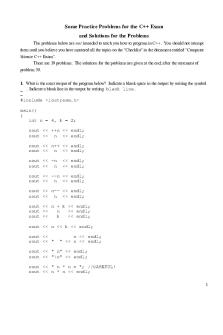Chapter 7 Practice Problems and Solutions PDF

| Title | Chapter 7 Practice Problems and Solutions |
|---|---|
| Course | Financial Management Ii |
| Institution | Wichita State University |
| Pages | 2 |
| File Size | 73.8 KB |
| File Type | |
| Total Downloads | 77 |
| Total Views | 165 |
Summary
Download Chapter 7 Practice Problems and Solutions PDF
Description
Chapter 7 Practice Problems FIN 440
P1.
The Marx Brewing Company recently installed a new bottling machine. The machine's initial cost is $2,000, and can be depreciated on a straight line basis to a zero salvage in 5 years. The machine's fixed cost per year is $1,800, and its variable cost is $0.50 per unit. The selling price per unit is $1.50. Marx's tax rate is 34%, and it uses a 16% discount rate. Calculate the accounting break-even point on the new machine, as well as the present value break-even point on the new machine.
A1.
Accounting break-even is: ($1,800 + $400) / ($1.50 - $0.5) = 2,200 units Present value break-even: PV BEP = [EAC + FC(1 - Tc) - Dep(T)]/[(Price per unit – VC per unit)(1 - T)) EAC on Calculator: N = 5 ; I/Y = 16 ; PV = -2000 ; Solve for PMT = 610.81 = EAC PV BEP = [$610.81 + $1,800(1 - .34) - $400(.34)]/($1.50 - $0.50)(1 - .34) = 2,519 units
P2.
Given the info below, calculate the accounting break-even point. Initial investment: $2,000 Fixed costs are $2,000 per year Variable costs: $6 per unit Depreciation: $250 per year Price: $20 per unit Discount rate: 10% Project life: 4 years Tax rate: 34%
A2.
Contribution Margin = ($20 - $6) = $14 (Fixed Cost + Depreciation) = ($2,000 + $250) = $2,250 Accounting BEP = $2,250/$14 = 160.71 units = 161 units
P3.
Given the following information, calculate the present value break-even point. Initial investment: $2,000 Fixed costs: $2,000 per year Variable costs: $6 per unit Depreciation: $250 per year Price: $20 per unit Discount rate: 10% Project life: 4 years Tax rate: 34%
A3.
Calculate EAC on calculator: N=4; I/Y=10; PV=2,000; Solve for PMT = -$630.93 = EAC PV BEP = [EAC + FC(1 - Tc) - Dep(Tc)]/(CM(1 - Tc)) = [$630.93 + $2,000(1 - 0.34) $250(.34)]/[($20 - $6)(1 - 0.34)] = 201.94 = 202 units
P4.
Under the base case, a project is expected to have a variable cost per unit of $10 and an NPV of $120. A sensitivity analysis has revealed that NPV is $72 if the variable cost per unit turns out to be 10% higher than expected. Given this information, you can conclude that a 1% increase in the variable cost per unit leads to a ______.
a. b. c. d. e. A4.
4% decrease in NPV 10% increase in NPV 4% increase in NPV 10% decrease in NPV None of the above
Answer: a. 4% decrease in NPV % Change in NPV, given 10% increase in variable cost per unit = ($72-$120)/$120 = -0.4 or -40% % Change in NPV, given 1% increase in variable cost per unit = -40%/10% = -4% Therefore, a 1% increase in the variable cost per unit leads to a 4% decrease in NPV....
Similar Free PDFs

Chapter 1 Problems and solutions
- 3 Pages

Chapter 11 problems and solutions
- 35 Pages

Chapter 9 Problems and solutions
- 39 Pages

Chapter 9 Problems & Solutions
- 4 Pages
Popular Institutions
- Tinajero National High School - Annex
- Politeknik Caltex Riau
- Yokohama City University
- SGT University
- University of Al-Qadisiyah
- Divine Word College of Vigan
- Techniek College Rotterdam
- Universidade de Santiago
- Universiti Teknologi MARA Cawangan Johor Kampus Pasir Gudang
- Poltekkes Kemenkes Yogyakarta
- Baguio City National High School
- Colegio san marcos
- preparatoria uno
- Centro de Bachillerato Tecnológico Industrial y de Servicios No. 107
- Dalian Maritime University
- Quang Trung Secondary School
- Colegio Tecnológico en Informática
- Corporación Regional de Educación Superior
- Grupo CEDVA
- Dar Al Uloom University
- Centro de Estudios Preuniversitarios de la Universidad Nacional de Ingeniería
- 上智大学
- Aakash International School, Nuna Majara
- San Felipe Neri Catholic School
- Kang Chiao International School - New Taipei City
- Misamis Occidental National High School
- Institución Educativa Escuela Normal Juan Ladrilleros
- Kolehiyo ng Pantukan
- Batanes State College
- Instituto Continental
- Sekolah Menengah Kejuruan Kesehatan Kaltara (Tarakan)
- Colegio de La Inmaculada Concepcion - Cebu









![3.1 Additional Practice Problems [ Solutions]](https://pdfedu.com/img/crop/172x258/70389dok72ew.jpg)

